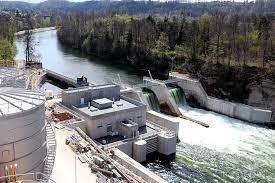Hydro Electric Power Plants
Hydro-electric power plants utilise the potential energy of water to move hydraulic urbines which are coupled to electric generators. Therefore, these plants have to be located where the water resources are available in abundance at sufficient head.
The first hydro power plant was set up in 1897 at Darjeeling of 200KW capacity and the first major hydro-electric power plant was commissioned in 1902 of 4.5 MW capacity of Sivasamudram scheme in Mysore.
Principle of Operation of Hydro-Electric Power Plants :
- In hydro-electric power plants the energy of water is utilised to move the hydraulic turbines which in turn runs an electric generator to convert the mechanical energy of turbine into electric energy
- The rain water that flows on the earth’s surface has potential energy relative to the ocean towards which it flows.
- In hydro-electric power plants, the water is collected and artificially stored by constructing dams across the flowing streams.
- This potential energy of water is converted into mechanical work and ultimately into electrical energy The power developed by the hydraulic turbine depends on the quantity of water and the head of water available,
- Input power to a hydraulic turbine is given by the equation,
P = p . g . Q . H (kg/m3 X m/s2 X m3/s X m = kgm s2 X m/s = Nm/s or W)
P = p . g . Q . H / 1000 kW ;
where p = density Q = discharge and H = available head of water
- The quantity of water available at the selected site depends upon the rainfall and run-off in that area.
- Presently, India generates about 14 % of hydro power out of total power generation from all sources.

